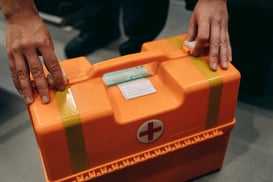 The Occupational Safety and Health Administration (OSHA) “Medical Services and First Aid Standard” requires employers to provide their employees with ready access to medical attention, including treatment and consultation, in the event of an occupational injury or illness. (29 CFR 1910.151). These services can be made available onsite, or at medical facilities in “near proximity” for use by injured employees. This Standard has not been revised since OSHA adopted it in 1998, but the agency has updated and expanded compliance guidance in the intervening 25 years; this includes OSHA’s “Best Practices Guide: Fundamentals of a Workplace First-Aid Program” (2006). The rest of this note discusses these requirements.
The Occupational Safety and Health Administration (OSHA) “Medical Services and First Aid Standard” requires employers to provide their employees with ready access to medical attention, including treatment and consultation, in the event of an occupational injury or illness. (29 CFR 1910.151). These services can be made available onsite, or at medical facilities in “near proximity” for use by injured employees. This Standard has not been revised since OSHA adopted it in 1998, but the agency has updated and expanded compliance guidance in the intervening 25 years; this includes OSHA’s “Best Practices Guide: Fundamentals of a Workplace First-Aid Program” (2006). The rest of this note discusses these requirements.
Making medical personnel available
Employers must “ensure the ready availability of medical personnel for advice and consultation on matters of plant health.” OSHA interprets the term “plant health” to mean “the overall safety and health condition of the employees.” This requirement can be met in two ways:
-
Providing onsite services and resources
An employer can choose to provide for onsite first aid and response to injuries and illnesses, either to attempt to control foreseeable medical situations or because no offsite medical services are sufficiently nearby (see below). An employer that uses this option must do the following:
- Make “adequate” first aid supplies “readily available” – OSHA’s Best Practices Guide provides refers employers to American National Standard Institute (ANSI) Z308.1-2003 (Minimum Requirements for Workplace First Aid Kits), and suggests that employers provide automatic external defibrillators (AEDs)
- Ensure at least one person is “adequately trained to render first aid” – which requires determination of first aid scenarios at each facility; this requirement applies whenever at least one employee is present at your facility, so employers must consider scheduling and shifts (including backup personnel)
OSHA does not explicitly require employers to designate first aid providers, but employers should consider doing so to ensure the presence of adequately trained responders. An employer that does designate and train responders should determine whether OSHA’s Bloodborne Pathogen Standard will apply (I wrote about the BBP Standard HERE.). OSHA recommends that designated first aid personnel receive annual CPR retesting, and refresher training in other first aid skills and knowledge at least every three years.
-
Relying on (nearby) offsite medical resources
Instead of relying on onsite personnel, an employer can rely on the presence of an infirmary, clinic, or hospital “in near proximity” to the workplace for the treatment of all injured employees. The regulation does not define this important term, but longstanding OSHA interpretations allow for medical response within the following time limits:
- 3-4 minutes, where accidents resulting in suffocation, severe bleeding, or other life threatening injury or illness can be expected
- 15 minutes, where a life-threatening injury is an “unlikely outcome of an accident”
These time limits can be met if the injured or ill employee can be transported to the medical services, or if medical services can be summoned to the workplace within those time limits. OSHA considers the “reasonable availability” of emergency service providers such as fire department paramedics or EMS responders to satisfy these requirements. However, if an employer relies on offsite responders it should take appropriate pre-emergency steps such as verifying response times. For example, OSHA has stated that a policy that encourages employees to call “911” does not violate these requirements, but does not (reliably) fulfill them either since a “911” call does not ensure a specific response time.
Providing emergency showers and/or eyewash stations if necessary
As a special case in addition to the general situations addressed above, if employees’ eyes or bodies might be exposed to “injurious corrosive materials,” the employer provide emergency drench showers and/or eye washes within the work area for immediate emergency use. Employers should consider provision of this equipment if exposure to other hazardous materials are possible, and may be required to do so by other applicable OSHA standards (such as the Laboratory Standard, which I wrote about HERE). If this equipment is onsite, it must be adequately maintained and should be inspected and/or tested periodically.
Now what?
These requirements have been in place for 25 years, but employers’ practical need to maintain first aid and medical response services are dynamic reflections of evolving activities (and associated hazards) at each workplace. Employers should regularly review the adequacy of onsite measures and any offsite resources relied on to ensure effective response to workplace injuries and illnesses.
Self-Assessment Checklist
Does each of the organization’s worksites provide for first aid and other medical services to respond to workplace injuries and illnesses?
- Are first aid supplies kept onsite?
- Are any employees trained to provide first aid, and if so are specific employees designated to do so?
- Has the employer identified offsite response and medical resources available if needed to respond to injuries and illnesses?
- Does the employer provide onsite drench showers and/or eye wash stations?
If so, has the employer reviewed these onsite activities and offsite resources to determine if they meet the requirements of OSHA’s Medical Services and First Aid Standard?
Where Can I Go For More Information?
- OSHA Medical and First Aid web portal
- Best Practices Guide: Fundamentals of a Workplace First-Aid Program (2006)
About the Author
 Jon Elliott is President of Touchstone Environmental and has been a major contributor to STP’s product range for over 30 years.
Jon Elliott is President of Touchstone Environmental and has been a major contributor to STP’s product range for over 30 years.
Mr. Elliott has a diverse educational background. In addition to his Juris Doctor (University of California, Boalt Hall School of Law, 1981), he holds a Master of Public Policy (Goldman School of Public Policy [GSPP], UC Berkeley, 1980), and a Bachelor of Science in Mechanical Engineering (Princeton University, 1977).
Mr. Elliott is active in professional and community organizations. In addition, he is a past chairman of the Board of Directors of the GSPP Alumni Association, and past member of the Executive Committee of the State Bar of California's Environmental Law Section (including past chair of its Legislative Committee).
You may contact Mr. Elliott directly at: tei@ix.netcom.com
